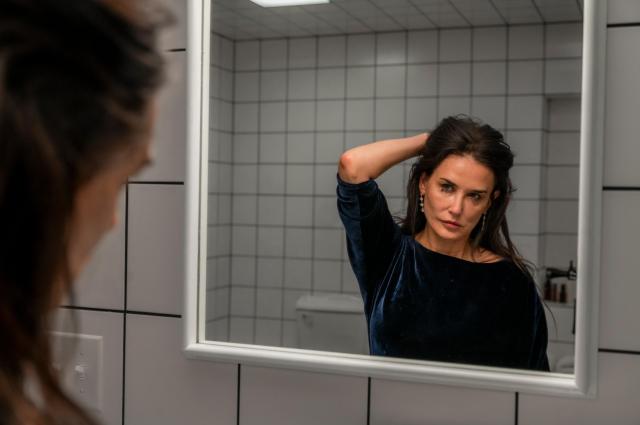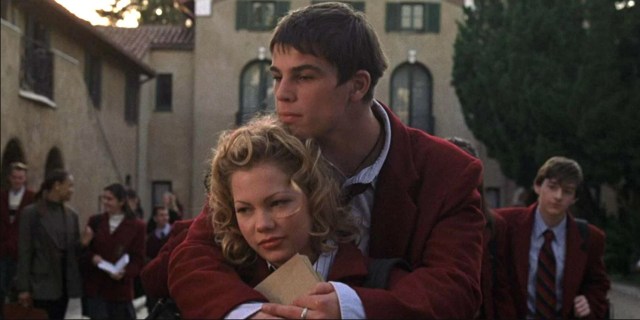Urban Legend is a 1998 teen slasher film that is especially fun to watch because it re-enacts or references so many urban legends that the audience is familiar with. The very first scene plays on one of the most popular urban legends of all time: the man in the backseat. Expectations are cleverly subverted when the creepy gas station attendant turns out to be a good Samaritan wishing to warn the scene’s protagonist that there is someone hiding in the backseat of her car. Because she did not heed his warning (and as we find out later, due to her past misdeeds) the killer in the backseat murders her as she drives away, singing the verse from Bonnie Tyler’s “Total Eclipse of the Heart”: Turn around.

Urban Legend (1998) plot summary:
The film is one of many that owes its lineage to Scream (1996), the first meta slasher in which the characters are aware of movie tropes and navigate their lives accordingly. In Urban Legend it isn’t horror movie tropes, but urban legends that the killer is acting out in their rampage. The character’s knowledge of urban legends adds a layer of believability and intrigue to what is otherwise a familiar “kids get slaughtered at college” movie.
The plot follows a group of students at the fictional Pendleton University following the opening character’s death. Natalie Simon (Alicia Witt) and her friend Brenda Bates (Rebecca Gayheart) discuss the rumor that there was once a massacre on an abandoned dorm at their school with frat boys Damon (Joshua Jackson) and Parker (Michael Rosenbaum). Jared Leto plays a real Gale Weathers type student journalist, Paul Gardner, who will do anything for a story and Robert Englund (of Freddy Krueger fame) has a small role as Professor William Wexler. The students and faculty at Pendleton begin to die off at the hands of a hooded killer who frames each kill as an urban legend.
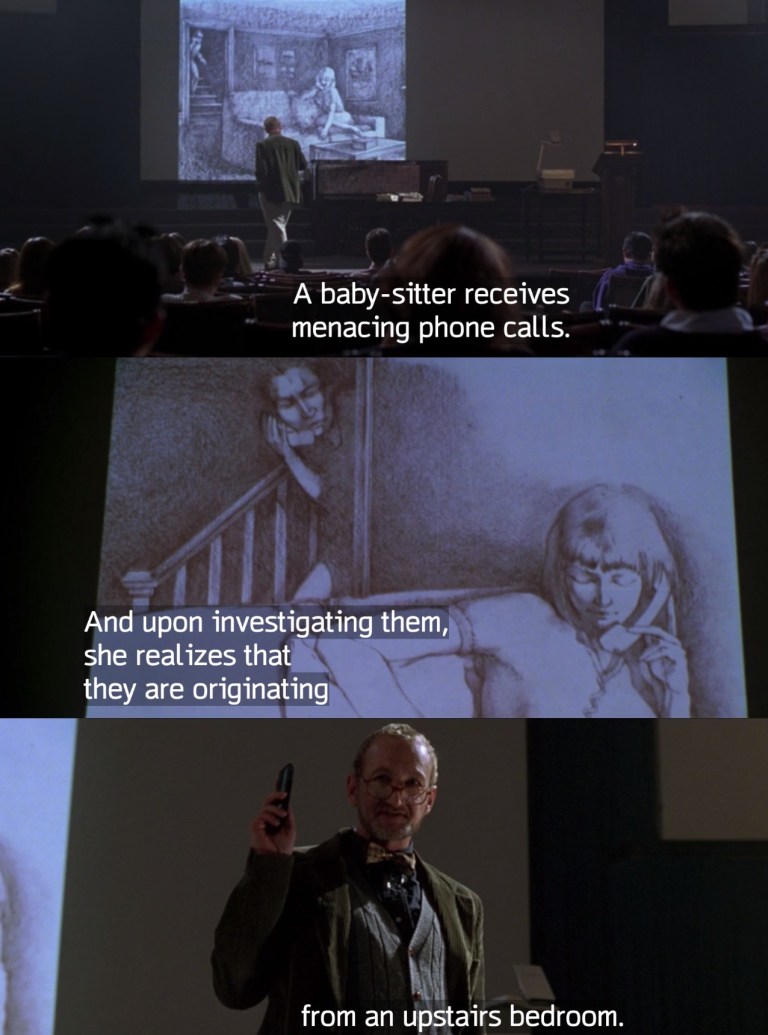
In the end we learn this is because the killer, (tap to reveal spoiler) Brenda, is angry that her fiance was killed when Natalie and Michelle, revealed to be high school friends, recklessly engaged in a high speed chase with him while playing a “prank” based on the urban legend that running someone off the road after they flash their headlights is a gang initiation rite. During the brutal third act the killer delivers a PowerPoint (iconic) explaining her motive while preparing to act out the “stolen kidney” urban legend with Natalie. The film ends with students at another college reciting the plot of Urban Legend as if it is an actual urban legend.
What actually is an “urban legend”?
Urban legends are a subgenre of folklore consisting of stories circulated (generally by word of mouth and social media) for the purpose of confirming prejudices or “moral standards” or to make sense of anxieties about the modern world. The stories are also told with the intention to entertain and must contain some element that is shocking or funny and leaves the audience with a sense of outrage, disgust, superiority and/or horror. Urban legends are always presented as “true stories” that happened to someone the teller vaguely knows, usually a “friend of a friend”. One way to think about urban legends is as updated morality tales for the current generation.

The most important book about urban legends is Jan Harold Brunvand’s non-fiction book The Vanishing Hitchhiker, published in 1981. The title is a reference to one of the most popular urban legends of all time in which a person picks up a hitchhiker who later vanishes from their vehicle. The protagonist often goes to the hitchhiker’s stated destination only to discover they died years ago and the hitchhiker was actually a ghost.
The point of such references is to forge a connection between aspects of pop culture, between urban legends and horror movies. Their history is interconnected and the movie seems to acknowledge that point. Modern folklore and horror movies both serve the same function in 1990s America, as stories that scare though often subtextual context or situations but which nonetheless hold power over their audience.
John Kenneth Muir, on ‘Urban Legend’ and urban legends
In The Vanishing Hitchhiker, Brunvand argues that urban legends help us understand our values as a culture saying, “We are not aware of our own folklore anymore than we are of the grammatical rules of our language.” Though we don’t consider the message we want to send when we share “friend of a friend” stories, their existence and proliferation tells us what captures our attention and which morality tales we care about preserving. This is true of all groups of people, he traces the title legend back to 1870 and found similar legends in Korea, Russia, in Chinese-American communities and in the Ozarks.
A copy of The Vanishing Hitchhiker can be seen on Professor Wexler’s desk in the film.
‘Urban Legend’ trivia:
- Screenwriter Silvio Horta, a first-generation Cuban-American, came up with the idea while he was working at the perfume counter at Nordstrom after college. He went on to create Jake 2.0 and the American version of Ugly Betty. Unfortunately Horta died by suicide in 2020.
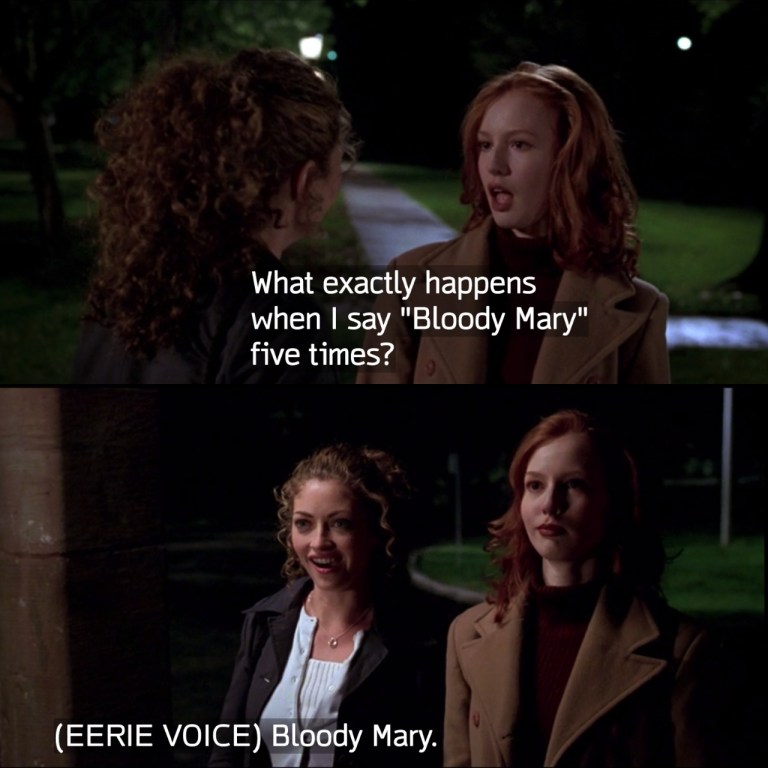
2. Reese Witherspoon, Jennifer Love Hewitt and Melissa Joan Hart all turned down the leading role.
3. The film opens with Pendleton University student Michelle Mancini (Natasha Gregson Wagner) driving in the rain and listening to Sasha Thomas’ (Tara Reid) radio show. The caller says she has been replacing her roommate’s birth control pills with baby aspirin. This is the film’s first urban legend that is said to have happened with a teenage girl using her mother’s birth control pills and replacing them with baby aspirin. In the story, the mother ends up pregnant.

4. In the opening, Michelle drives a Ford Expedition because production discovered it is the only SUV large enough to swing an axe inside.

5. Also in the opening, the gas station attendant is played by Brad Dourif, the character of Charles Lee Ray and the voice of Chucky in Child’s Play (1988) and many of the sequels. This means both Chucky and Freddy Kreuger (Robert Englund plays Professor Wexler) are in this movie.
6. Michelle’s last name is “Mancini” as a reference to Child’s Play creator Don Mancini.
7. Urban Legend was filmed at the University of Toronto, which was made to look like the fictional Pendleton University. A similar film, Killer Party (1986), was also made at the school.
8. In the following years, Joshua Jackson filmed two other movies at this location: The Skulls (2000) and Gossip (2000).
9. The movie was originally set in winter, which is why the killer wears a fur-lined hooded overcoat. However, it was shot in the spring and it was too complicated and expensive to add snow to every scene so the dropped the winter idea except for the killer’s outfit.
10. Brenda’s last name, Bates, is a reference to Norman Bates in Psycho (1964).
11. For some reason Jared Leto refuses to talk about this movie.

12. The 90s television show Beyond Belief: Fact or Fiction was based on debunking urban legends and featured a series of true stories and urban legends in each episode. Many of the urban legends in the film were also featured on the show.
13. The idea was for Rebecca Gayheart’s hair to be straightened during most of the film so people “wouldn’t guess that she is the villain”. However, there are a few scenes where her curly natural hair is present in addition to the finale.
14. The character of Reese the security guard (Loretta Devine) was written as gay but this was either changed or just not shown in the film.
15. The main character’s goth roommate Tosh, played by Danielle Harris, is recognizable to horror fans as Jamie Lloyd from Halloween 4 (1988) and Halloween 5 (1989).

16. Sarah Michelle Gellar was going to play the role of Sasha the radio host, but had to back out because of conflicts with Buffy the Vampire Slayer and the role went to Tara Reid.
17. Tara Reid and Joshua Jackson were also working on Cruel Intentions (1999) during this time.

18. Joshua Jackson and Rebecca Gayheart also appeared in Scream 2 (1997) together.
19. Many of the actors in Urban Legend (Julian Richings, Loretta Devine, Alicia Witt, and Robert Englund) subsequently appeared on the television show Supernatural.
20. Danielle Harris quit smoking after this movie because she had to smoke so many cigarettes while filming Tosh’s scenes.
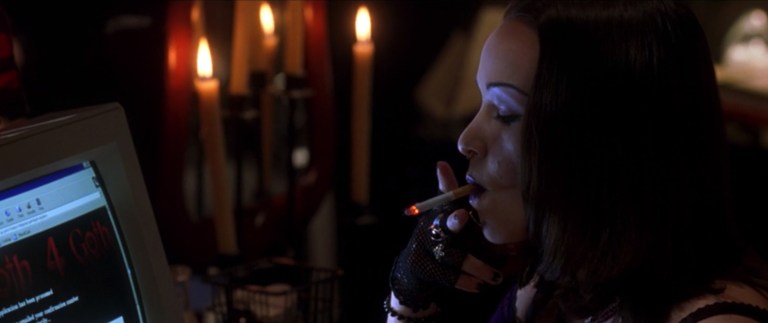
21. Rebecca Gayheart had to do the scene where she eats Pop Rocks so many times they made her sick.

22. For a slasher film, Urban Legend is intentionally light on violence. Director Jamie Blanks tried to keep the death scenes in the viewers imagination rather than showing too much of the kills on screen.
23. The scene where Damon’s car plays Paula Cole’s “I Don’t Wanna Wait” is a reference to Joshua Jackson’s Dawson’s Creek fame.

24. Pendleton’s school motto is shown only in Latin. When translated, it means “The Best Friend Did It”.
25. Brenda’s motivation for the murders is that Natalie and Michelle killed her fiancé in a car accident but were only charged with reckless endangerment. Unfortunately, in 2001 Rebecca Gayheart struck a 9-year-old boy while driving in Los Angeles and he died from his injuries the following day. Gayheart was charged with vehicular manslaughter and received three years of probation, one year of a suspended license, a $2,800 fine, and 750 hours of community service. She also paid the family $10,000 for funeral expenses. Afterwards the family sued Gayheart and she settled out of court.

26. The film ends with students telling the “urban legend” of the events of the film. One jokes that Brenda was “the girl in the Noxema commercial” which is actually true, Rebecca Gayheart was in a Noxema commercial.
27. In this scene Rebecca Gayheart also wears a blue ribbon around her neck, a reference to the urban legend of “The Girl with the Green Ribbon”.
28. The franchise continued with Urban Legends: Final Cut (2000) and Urban Legends: Bloody Mary (2005). Both Rebecca Gayheart and Loretta Devine appeared in the first sequel.

29. As Alexandra West argues, “The final scene signals why the title of the film is singular and not plural; Urban Legend is not a movie about a serial killer using urban legends to kill people, it is an urban legend itself.”



